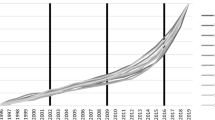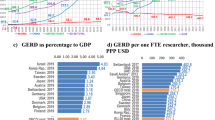Abstract
The Russian project for enhancing competitive ability enforced top 21 universities to stimulate the research output actively. The results surpassed expectations with the fivefold increase in the number of publications from 2010 to 2016. This paper discusses the background and reasons for this phenomenal rise and explores in detail the most significant strategies to boost research productivity and publication output. In our study, a classification of university publications is proposed in accordance with the strategies for stimulating the publication activity, mainly corresponding with the set of measures applied by university management. The analysis made it possible to rank the strategies for contributing to the growth of publication activity, to identify the leading strategies for individual universities, and showed a significant difference between universities in the set of explicitly or implicitly applied strategies. The most effective strategy was the Additional paper, associated with the authors, indicated the affiliation of the university as complementary to their main institution. The next most important and fastest growing was the Russian conferences strategy thanks to the efforts of the organizers of domestic conferences to promote their proceedings in Scopus. A notable place is also occupied by the strategy connected with the attraction of prominent authors, which we called Headhunted author. It was possible to determine the role of the Predatory journals strategy in the growth of the publication activity, fortunately, this strategy turned out to be highly localized in only 2 of the 21 universities participating in the project and is visibly declining. It was possible to show that the share of publications in domestic journals, despite the constant increase in their presence in Scopus is steadily falling in the case of leading universities. One of the significant results of the study is an assessment of the dynamics of the average authors’ productivity, which grows insignificantly and almost reached one article per author per year. This fact also shows that the growth of publication activity of top Russian universities is mainly associated with an increase in the number of faculty involved.











Similar content being viewed by others
Notes
According to Scimago Journal Ranks, there were 270 Russian journals in Scopus in 2016, having distribution by quartiles Q1–Q4: 7/46/100/107.
References
Altbach, P. G., Reisberg, L., & Pacheco, I. F. (2012). Paying the professoriate: A global comparison of compensation and contracts. New York: Routledge.
Aref’ev, A. L. (2015). On participation of Russian universities in international ranks. Rossiya reformiruyuschayasya, 13, 213–231.
Block, M., & Khvatova, T. (2017). University transformation: Explaining policy making and trends in higher education in Russia. Journal of Management Development, 36(6), 761–779. https://doi.org/10.1108/JMD-01-2016-0020.
Chou, C. P., & Ching, G. (2012). Taiwan education at the crossroad. When globalization meets localization. New York: Palgrave Macmillan.
Galazhinskiy, E. V., & Kollantai, J. A. (2016). Academic publishing at National Research Tomsk State University. Higher Education in Russia and Beyond, 1, 21–23.
Garousi, V., & Fernandes, J. M. (2017). Quantity versus impact of software engineering papers: A quantitative study. Scientometrics, 112(2), 963–1006. https://doi.org/10.1007/s11192-017-2419-6.
Gokhberg, L., Kuznetsova, T., & Zaichenko, S. (2009). Towards a new role of universities in Russia: Prospects and limitations. Science and Public Policy, 36(2), 121–126. https://doi.org/10.3152/030234209X413946.
Guskov, A., Kosyakov, D., & Selivanova, I. (2017). Strategies to improve publication activities of the universities participating in Project 5-100. Nauchnye I Tekhnicheskie Biblioteki-Scientific and Technical Libraries, 12, 5–18.
Ivanov, V. V., Libkind, A. N., & Markusova, V. A. (2014). Publication activity and research cooperation between higher education institutions and the Russian Academy of Sciences. Herald of the Russian Academy of Sciences, 84(1), 28–34. https://doi.org/10.1134/s101933161401002x.
Ivanov, V. V., Markusova, V. A., & Mindeli, L. E. (2016). Government investments and the publishing activity of higher educational institutions: Bibliometric analysis. Herald of the Russian Academy of Sciences, 86(4), 314–321. https://doi.org/10.1134/s1019331616040031.
Klochikhin, E. A. (2012). Russia’s innovation policy: Stubborn path-dependencies and new approaches. Research Policy, 41(9), 1620–1630. https://doi.org/10.1016/j.respol.2012.03.023.
Kotsemir, M., & Shashnov, S. (2017). Measuring, analysis and visualization of research capacity of university at the level of departments and staff members. Scientometrics, 112(3), 1659–1689. https://doi.org/10.1007/s11192-017-2450-7.
Kupershtokh, N., & Apolonskiy, A. (2014). Physics in Novosibirsk and Akademgorodok. Physics in Perspective, 16(2), 250–276. https://doi.org/10.1007/s00016-014-0138-4.
Lee, G. (2000). Brain Korea 21: A development-oriented national policy in Korean higher education. International Higher Education, 19, 24–25. https://doi.org/10.6017/ihe.2000.19.6865.
Mazov, N. A., & Gureev, V. N. (2017). Bibliometric analysis of the flow of publications by Novosibirsk State University in collaboration with the RAS Siberian Branch. Herald of the Russian Academy of Sciences, 87(5), 445–453. https://doi.org/10.1134/S1019331617050057.
Mokhnacheva, Y. V., & Kharybina, T. N. (2011). Research performance of RAS institutions and Russian universities: A comparative bibliometric analysis. Herald of the Russian Academy of Sciences, 81(6), 569–574. https://doi.org/10.1134/S1019331611060104.
Osipov, I. A. (2016). Return on publications (RoP) and the changing nature of the ‘science enterprise’. Higher Education in Russia and Beyond, 1, 19–21.
Poldin, O., Matveeva, N., Sterligov, I., & Yudkevich, M. (2017). Publication activities of Russian universities: The effects of Project 5-100. Voprosy Obrazovaniya/Educational Studies Moscow, 2, 10–35. https://doi.org/10.17323/1814-9545-2017-2-10-35.
Rodionov, D. G., Yaluner, E. V., & Kushneva, O. A. (2014). Race to the top: The government programme “5-100-2020”. Vestnik LGU im. A.S. Pushkina, 6(2), 69–86.
Shin, J. C. (2009). Building world-class research university: The Brain Korea 21 project. Higher Education, 58(5), 669–688. https://doi.org/10.1007/s10734-009-9219-8.
Turko, T., Bakhturin, G., Bagan, V., Poloskov, S., & Gudym, D. (2016). Influence of the program “5-top 100” on the publication activity of Russian universities. Scientometrics, 109(2), 769–782. https://doi.org/10.1007/s11192-016-2060-9.
Yonezawa, A., & Shimmi, Y. (2015). Transformation of university governance through internationalization: Challenges for top universities and government policies in Japan. Higher Education, 70(2), 173–186. https://doi.org/10.1007/s10734-015-9863-0.
Zhang, H., Patton, D., & Kenney, M. (2013). Building global-class universities: Assessing the impact of the 985 Project. Research Policy, 42(3), 765–775. https://doi.org/10.1016/j.respol.2012.10.003.
Ziyatdinova, I., & Valeeva, R. (2012). Reforms in the systems of higher professional education in China and Russia: Late XXth–early XXIst centuries. Vysshee obrazovanie v Rossii [Higher Education in Russia], 5, 96–101.
Acknowledgements
The authors would like to thank Vadim N. Gureyev, Ph.D. for text improvements and valuable feedback.
Author information
Authors and Affiliations
Corresponding author
Rights and permissions
About this article
Cite this article
Guskov, A.E., Kosyakov, D.V. & Selivanova, I.V. Boosting research productivity in top Russian universities: the circumstances of breakthrough. Scientometrics 117, 1053–1080 (2018). https://doi.org/10.1007/s11192-018-2890-8
Received:
Published:
Issue Date:
DOI: https://doi.org/10.1007/s11192-018-2890-8




